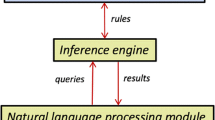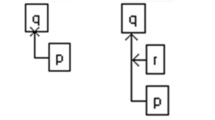Abstract
This article describes recent jurisprudential accountsof analogical legal reasoning andcompares them in detail to the computational modelof case-based legal argument inCATO. The jurisprudential models provide a theoryof relevance based on low-levellegal principles generated in a process ofcase-comparing reflective adjustment. Thejurisprudential critique focuses on the problemsof assigning weights to competingprinciples and dealing with erroneously decidedprecedents. CATO, a computerizedinstructional environment, employs ArtificialIntelligence techniques to teach lawstudents how to make basic legal argumentswith cases. The computational modelhelps students test legal hypotheses againsta database of legal cases, draws analogiesto problem scenarios from the database, andcomposes arguments by analogy with a setof argument moves. The CATO model accountsfor a number of the important featuresof the jurisprudential accounts, includingimplementing a kind of reflective adjustment.It also avoids some of the problems identifiedin the critique; for instance, it deals withweights in a non-numeric, context-sensitivemanner. The article concludes by describingthe contributions AI research can make tojurisprudential investigations of complexcognitive phenomena of legal reasoning. Forinstance, unlike the jurisprudential models,CATO provides a detailed account of how togenerate multiple interpretations of a citedcase, downplaying or emphasizing the legalsignificance of distinctions in terms of thepurposes of the law as the argument contextdemands.
Similar content being viewed by others
References
Aha, D. W. (1998) Feature Weighting for Lazy Learning Algorithms. In Liu, H. and Motoda, H. (eds.) Feature Extraction, Construction and Selection: A Data Mining Perspective, Kluwer.
Aleven, V. (1996). CATO Workbooks: Workbook I <http://adson.lrdc.pitt.edu/wb1.html>, Workbook I, Reference Pages, Section 7 <http://adson.lrdc.pitt.edu/ wb1.html# theorytesting>. Workbook II <http://adson.lrdc.pitt.edu/wb2.html>, Workbook 2, Section 3 <http://adson.lrdc.pitt.edu/wb2.html#importanceofdistinctions>. Workbook III <http://adson.lrdc.pitt.edu/wb3.html>, Workbook IV <http://adson.lrdc.pitt.edu/wb4.html>.
Aleven, V. (1997). Teaching Case-Based Argumentation Through a Model and Examples, Ph.D. dissertation, University of Pittsburgh Graduate Program in Intelligent Systems, (unnumbered technical report, Learning Research and Development Center).
Aleven, V. and Ashley, K. (1996). How Different is Different? Arguing about the Significance of Similarities and Differences. In Smith, I. and Faltings, B. (eds.) Proceedings 3d European Workshop on Case-Based Reasoning (EWCBR-96), 1–15. Springer Lecture Notes in Artificial Intelligence Series No. 1168.
Aleven, V. and Ashley, K. (1997). Teaching Case-Based Argumentation Through a Model and Examples: Empirical Evaluation of an Intelligent Learning Environment. In du Boulay, B. and Mizoguchi, R. (eds) Artificial Intelligence in Education, Proceedings AI-Ed 97 World Conference on Artificial Intelligence in Education, 87–94. (August) IOS Press.
Alexander, L. (1989). Constrained By Precedent, Southern California Law Review 63: 1.
Alexander, L. (1996). Bad Beginnings, University of Pennsylvania Law Review 145: 57–86.
Allen, L. E. and Saxon, C. S. (1987). Some Problems in Designing Expert Systems to Aid Legal Reasoning. In Proceedings of First International Conference on Artificial Intelligence and Law, 94–103. ACM Press.
Ashley, K. (1990). Modeling Legal Argument: Reasoning with Cases and Hypotheticals, The MIT Press.
Ashley, K. (1992). Case-Based Reasoning and Its Implications for Legal Expert Systems, Artificial Intelligence and Law 1: 150.
Ashley, K. and Aleven, V. (1996). Casebook Chapter on the Law of Trade Secret Misappropriation <http://adson.lrdc.pitt.edu/casebook1.html>.
Ashley, K. and Aleven, V. (1997). Reasoning Symbolically About Partially Matched Cases. In Proceedings International Joint Conference on Artificial Intelligence, IJCAI-97, 335–341. Morgan Kaufmann.
Ashley, K. and McLaren, B. (1995). Reasoning with Reasons in Case-Based Comparisons. In Veloso, M. and Aamodt, A. (eds) Proceedings of the First International Conference on Case-Based Reasoning (ICCBR-95), 133–144. Springer Lecture Notes in Artificial Intelligence Series No. 1010.
Beauchamp, T. and McCullough, L. B. (1984). Medical Ethics: The Moral Responsibilities of Physicians. Prentice-Hall.
Bench-Capon, T. and Sartor, G. (2001). Theory Based Explanation of Case Law Domains. In Proceedings 8th Int'l Conference on Artificial Intelligence and Law, 12–21. Association for Computing Machinery.
Berman, D. and Hafner, C. (1993). Representing Teleological Structure in Case-Based Legal Reasoning: The Missing Link in Proceedings of the Fourth International Conference on Artificial Intelligence and Law, 50–59. Association for Computing Machinery.
Berman, D. and Hafner, C. (1996). Obstacles to the Development of Logic-Based Models of Legal Reasoning. In Walter, C. (ed.) Computer Power and Legal Language. Greenwood Press.
Branting, L.K. (1991). Building Explanations from Rules and Structured Cases, Int'l Journal of Man-Machine Studies 34: 797–837.
Branting, K. (1994) A Computational Model of Ratio Decidendi, Artificial Intelligence and Law 2: 1–31.
Brewer, S. (1996). Exemplary Reasoning: Semantics, Pragmatics, and the Rational Force of Legal Argument by Analogy, Harvard Law Review 109: 923–1028.
Burton, S. (1995). An Introduction to Law and Legal Reasoning, 2d ed. Little, Brown.
Cross, R. (1979). Precedent in English Law, 3d ed. Oxford University Press.
Gardner, A. vdL. (1987). An Artificial Intelligence Approach to Legal Reasoning, MIT Press.
Goldstein, P. (1990). Copyright, Patent, Trademark and Related State Doctrines, 3d ed. Foundation Press.
Horty, J. F. (1999). Precedent, Deontic Logic, and Inheritance. In Proceedings, Seventh International Conference on Artificial Intelligence and Law, 63–71. Association of Computing Machinery.
Levi, E. (1949). An Introduction to Legal Reasoning, University of Chicago Press.
Llewellyn, K. (1960). The Bramble Bush. On Our Law and Its Study. Oceana Publications 1986.
McCarty, L. T. (1977). Reflections on TAXMAN: An Experiment in Artificial Intelligence and Legal Reasoning. Harvard Law Review 90: 837–893.
McCarty, L. T. (1989). A Language for Legal Discourse: I. Basic Features. In Proceedings of Second International Conference on Artificial Intelligence and Law, 180–189. Association of Computing Machinery.
McCarty, L. T. and Sridharan, N. S. (1981). The Representation of an Evolving System of Legal Concepts: II. Prototypes and Deformations. LRP-TR-11. Lab. for Computer Science Res. Rutgers U. New Brunswick, NJ.
McLaren, B. (1999). Assessing the Relevance of Cases and Principles Using Operationalization Techniques. Ph.D. dissertation, University of Pittsburgh Graduate Program in Intelligent Systems.
Milgrim, R. M. (1995). Business Organizations,Milgrim on Trade Secrets, vol. 12. Matthew Bender.
Minsky, M. L. (1968) Semantic Information Processing. MIT Press.
Prakken, H. and Sartor, G. (1997). Reasoning with Precedents in a Dialogue Game. In Proceedings of the Sixth International Conference on Artificial Intelligence and Law, 1–9. Association for Computing Machinery.
Rissland, E. L. (1990). Artificial Intelligence and Law: Stepping Stones to a Model of Legal Reasoning, Yale Law Journal 99: 1957–1981.
Rissland, E. L., Skalak, D. B. et al. (1996). BankXX: Supporting Legal Arguments Through Heuristic Retrieval, Artificial Intelligence and Law 4: 19.
Rose, D. E. and Belew, R. K. (1991). A Connectionist and Symbolic Hybrid for Improving Legal Research, International Journal of Man-Machine Studies 35: 1–33.
Schaffner, K. F. (1990). Presentation entitled “Case-Based Reasoning in Law and Ethics” at the Foundations of Bioethics Conference. Hastings Center. December.
Sergot, M. J. et al. (1986). The British Nationality Act as a Logic Program, Comm. of the ACM 29: 370–386.
Sunstein, C. R. (1993). On Analogical Reasoning, Harvard Law Review 106: 741–791.
Waterman, D. A. and Peterson, M. (1981). Models of Legal Decision-making. Technical Report R-2717-1CJ. Rand Corporation. Santa Monica, CA.
Yoshino, H. (1998). Logical Structure of Contract Law System, J. Adv. Comp. Intelligence 2: 2–11.
Zeleznikow, J. Stranieri, A. et al. (1995- 1996). Project Report: Split-Up - A Legal Expert System which Determines Property Division Upon Divorce, Artificial Intelligence and Law 3: 267–275.
Author information
Authors and Affiliations
Rights and permissions
About this article
Cite this article
Ashley, K.D. An AI model of case-based legal argument from a jurisprudential viewpoint. Artificial Intelligence and Law 10, 163–218 (2002). https://doi.org/10.1023/A:1019513821567
Issue Date:
DOI: https://doi.org/10.1023/A:1019513821567




